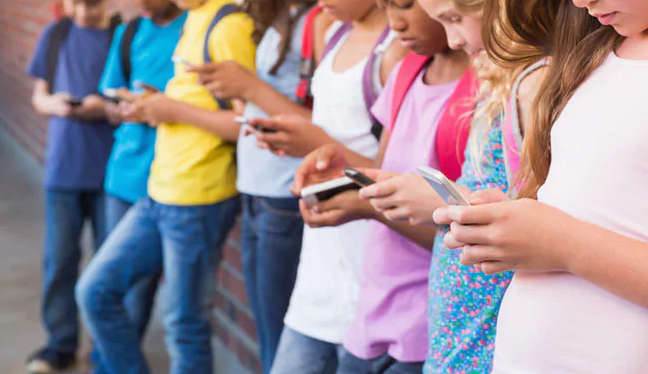(单词翻译:单击)
听力文本
Schools, Stress and Smartphones
High school biology teacher Kelly Chavis knew smartphones were a problem in her class. But not even the students realized how much of a problem the devices were until Chavis did an in-class experiment.
For one class period, students used a whiteboard to count every Snapchat, Instagram, text, call or other notification that appeared on their phones. Chavis told students to not respond to these notifications.
Teachers around the country have done similar experiments, usually recording dozens of markings on the whiteboard.
Chavis, who teaches honors-level classes at Rock Hill Schools in South Carolina, was shocked by the results of her experiment.
"One girl, just during the one hour, got close to 150 Snapchat notifications. 150!" she said.
Chavis is among a growing number of teachers, parents and health experts who believe that smartphones are now partly to blame for increasing the levels of student anxiety. The use of electronic devices is so widespread that the National Education Association newsletter said it was a "mental health tsunami."
Tests, after-school activities and problems at home can increase stress for students. But research now suggests that smartphones and social media are some of the main reasons for the rising anxiety levels.
Jean Twenge is a psychology professor at San Diego State University in California. Twenge said it is not a coincidence that youth mental health issues have risen with the number of phones. "What a lot of teens told me is that social media and their phones feel mandatory," she said. This use of phones has led to a loss of sleep and face-to-face interactions necessary for their mental well-being.
Last year, an editorial in the journal Pediatrics proposed that doctors ask young patients about their social media use as part of routine exams. Three researchers wrote that too much social media use might "contribute to the development of mental health disturbance in at-risk teenagers, such as feelings of isolation, depressive symptoms, and anxiety."

Researchers are still not sure whether phones cause student depression or depression causes phone use. Yet 70 percent of teens see anxiety and depression as major problems among their peers, according to a February Pew Research Center report.
Nearly 60 percent of parents said they worry about the influence of social media on their child's physical and mental health. That number comes from the American Psychological Association's 2017 Stress in America survey.
Schools are starting to take steps to deal with the problem. Many public schools pay outside companies to watch students' social media activity for signs of distress. Others invite in yoga teachers and comfort dogs to help calm students.
Some schools have organized #unplugged events – days in which people do not use their electronic devices. Belfast Area High School in Maine had one such event in April. Less than 20 percent of students and school employees took part, demonstrating the influence that the technology has on their daily lives.
Emily Mogavero is a 17-year-old student in Buffalo, New York. "I definitely feel stress with online profiles, social media, to keep up, maintain my profiles and stuff," she said. "It kind of worries me that I'm on my phone so much." Mogavero said she sometimes puts her phone out of reach or powers it down so she doesn't hear notifications.
Some parents are not letting their children get smartphones until they grow up. Western New York yoga teacher Erin Schifferli says her 12-year-old daughter, Aeva, won't get a phone until she is 16 years old.
Deirdre Birmingham of Montclair, New Jersey, signed onto a campaign called "Wait Until Eighth" because she didn't think her video game-loving 10-year-old son was ready for a smartphone. The campaign joins groups of parents who have children in the same class. These parents agree to not let their children get phones until they are teenagers, or in the 8th grade.
Birmingham said she had a feeling that the phone "would be difficult for my child to manage....As a grown-up, I find it difficult sometimes to manage."
I'm John Russell. And I'm Ashley Thompson.
重点解析
重点讲解:
1. respond to 长大;成长;
Even very young premature babies respond to their mother's presence.
即使是很小的早产儿也会对母亲的出现做出反应。
2. dozens of 几十个;很多;
Dozens of doctors and nurses have been working day and night for weeks.
很多医生和护士已经夜以继日地工作数周了。
3. contribute to 有助于;促成;
This will contribute to promoting the full and equal participation of all women in society.
这将有助于促进所有妇女充分和平等地参与社会。
4. out of reach 够不着的;超出范围的;
She didn't understand why the TV was kept out of reach of the patients.
她不明白为什么病人不能看电视。
参考译文
学校、压力与智能手机
高中生物老师凯莉·查维斯知道智能手机是她班上的一个问题。但是,直到查维斯做了一个课堂实验,学生们才意识到这种设备的问题到底有多大。
在一堂课的时间里,学生们用白板计下自己手机上每次出现Snapchat、Ins、短信、通话或其他消息的次数。查维斯告诉学生不要回复这些消息。
全国各地的教师都做过类似的实验,通常会在白板上记录几十个标记。
在南卡罗来纳州的石山学校,教授荣誉等级课程的查维斯,对她的实验结果感到震惊。
“有个女生在一个小时内,收到将近150条Snapchat的消息。150条啊!”她说。
查维斯与越来越多的教师、家长和健康专家一样,认为智能手机是目前导致学生焦虑程度增加的部分原因。电子设备的使用非常广泛,以至于全国教育协会的简讯称这是一场“心理健康海啸”。
考试、课外活动和家庭问题会增加学生的压力。但现在的研究表明,智能手机和社交媒体是导致焦虑水平上升的一些主要原因。
特吉·特温格是加州圣地亚哥州立大学的心理学教授,特温格说,年轻人的心理健康问题随着手机数量的增加而增加,这并非巧合。”很多青少年告诉我,社交媒体和手机给他们一种强制感。手机的使用导致睡眠丧失和面对面交流,而这些都是心理健康所必需的因素。
去年,《儿科》期刊上的一篇社论建议,医生向年轻患者询问他们的社交媒体使用情况,以此作为常规检查的一部分。三位研究人员写道,过多使用社交媒体可能“使高危青少年出现心理健康障碍,如感到孤独、抑郁症状和焦虑。”
研究人员仍不确定,到底是手机导致学生抑郁,还是抑郁致使学生使用手机。然而,根据二月份皮尤研究中心(Pew Research Center)的一份报告,70%的青少年认为焦虑和抑郁是同龄人的主要问题。
近60%的家长表示,他们担心社交媒体对孩子身心健康的影响。这个数字来自美国心理协会2017年的美国人压力状况调查。
学校开始采取措施解决这个问题,许多公立学校付钱聘请外面的公司,让他们查看学生的社交媒体行为,寻找学生感到痛苦的迹象。其他学校则邀请瑜伽老师和安慰犬来安抚学生。
一些学校组织不插电活动,即在这些日子不使用电子设备。缅因州贝尔法斯特高中在四月份举办了一次这样的活动,不到20%的学生和学校员工参加,这表明科技对他们日常生活的影响。
埃米莉·马格瓦罗是纽约州水牛城一名17岁的学生,她说:“我对网上的个人资料、社交媒体感到压力重重,要更新、保有我的个人资料和相关信息。我有点担心自己用手机的时间有点长。”马格瓦罗说,她有时会把手机放在无法接触到的地方或者关机,这样就不会听到消息声了。
有些家长在孩子长大之前,不让他们使用智能手机。纽约州西部的瑜伽老师艾琳·希弗利说,她12岁的女儿艾娃,16岁时才能用手机。
新泽西州蒙特克莱尔的迪得莉·伯明翰签署参加一项名为“等到八年级”的活动,因为她认为自己爱玩电游的10岁儿子还没准备好用智能手机。这项活动把孩子在同年级的家长聚在一起,这些父母都同意等孩子长到十几岁或上八年级时,再给他们用手机。
伯明翰说,她觉得手机“对我的孩子来说,管理起来有点难。作为一个成年人,有时我都觉得很难控制手机的使用。”
罗素和阿什丽·汤普森报道。
译文为可可英语翻译,未经授权请勿转载!


